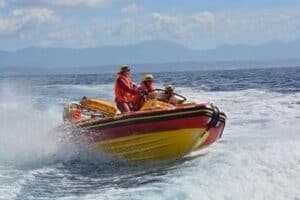The proposal has seen massive opposition from ratepayers and visitors, who in 2015 formed a human NO-sign on Central Beach.

The controversial R4 billion Plettenberg Bay small boat harbour development has reared its head once again after the initial scoping report was rejected by the Western Cape department of environmental affairs and development planning two years ago following massive opposition, reports the Knysna-Plett Herald.
The proposed 87 000 square metre development by Western Cape Marina Investments – earmarked for the Piesang River estuary and along the town’s popular Central Beach –has been a contentious issue for locals for several years now, but in April 2014 the developer’s scoping report was rejected following a series of technical and procedural shortcomings.
After two appeals to submit an amended and compliant report for the development – which was set to include 482 residential units, 1 343 square metres of office space, a 110-room 5-star hotel, mansions, 8 700 square metres of retail space, a plaza, a yacht club and more than 2 000 parking bays – the department on December 14 gave developers a new deadline for re-submission.
Developers now have until February 1 for the re-submission, with heavy emphasis having been placed on setting out a thorough public participation process should the development reach the Environmental Impact Assessment (EIA) stage.
The department, through MEC Anton Bredell, also instructed developers to include several aspects in its EIA, including a description of all other alternatives investigated, a market demand study and the results of an investigation of the development setback line as well as the 5m contour line.
The proposal has seen massive opposition from ratepayers and visitors, who in 2015 formed a human NO-sign on Central Beach, and prompted locals to establish the alliance and appoint a legal team to protect their interests.
Their main objections included the scope of the development being out of kilter with the size of the town as well as the potential impact the development could have on the environment.
In the final scoping report, these concerns were highlighted. These included the potential negative environmental and socioeconomic impacts, including the loss of important estuarine habitats through dredging and reclaiming portions of the estuary to accommodate the harbour.
ALSO READ: Jub Jub to release an ‘I’m sorry’ song
The report revealed that this could result in a reduction of diversity of estuarine biota that are dependent on these habitats and impact threatened species such as Steenbras.
The report also highlighted the potential impact on water quality, which could become contaminated by fuel, oil and concrete during the construction phase of the project. Other environmental concerns include air and noise pollution.
Findings of the preliminary social investigation done by Dr Anton de Wit suggested that there were positive and negative social impacts from the proposed development. Positive impacts included socioeconomic benefits as a result of employment creation, and empowerment benefits through skills development and training in the construction phase, in particular.
It was expected that during the four years of construction more than 960 jobs would be created per year, with about 460 being direct jobs.
De Wit’s study also highlighted a number of potential negative impacts, including sociocultural conflicts, intrusion impacts and the resultant decrease in tourism and indirect impacts on businesses in the construction phase.
It is proposed to build a small-boat harbour in the Piesang Estuary in the area between Beacon Isle and the road bridge over the river 600 m upstream from the estuary mouth. Picture: Ewald Stander






